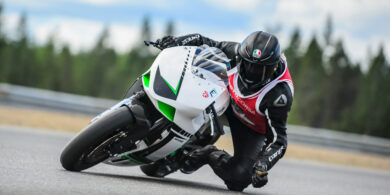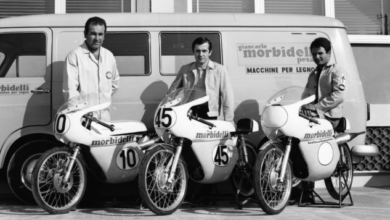Cruisers 2004
Model year 2004 saw the introduction of a few significant new motorcycles in the cruiser segment. Big motorcycles.
For instance, Kawasaki rolled out the Vulcan 2000, powered by the biggest OEM V-twin engine on the market. In spite of its large size, Patrick Kelly, Kawasaki’s product manager, says, “The Vulcan 2000 handles and feels like a much lighter machine than it is and stops on a dime thanks to four piston caliper front brakes. In fact, as large as it is, it weighs approximately the same as our existing 1500 Nomad.” The Nomad weighs 743 pounds dry.
Also competing in the big heavyweight cruiser class, Honda has the new-for-2004 1800cc Valkyrie Rune. This hot-rod styled motorcycle boasts the longest wheelbase in Honda’s lineup at 68.9 inches. It’s based on a concept cruiser that Honda revealed at the Tokyo Motor Show in 1995 and proved that Honda can actually build a street-worthy bike from one of those flashy, “dream-about-only” concept bikes that grace trade show floors.
Another new Honda on the heavyweight side is the 1800VTXN, the “N” for neo-retro styling, and the VTX1300C resembling the performance custom look of the VTX1800C. Honda also introduced its new custom building option program giving customers the opportunity to customize their VTX with 40 different combinations of parts and accessories right from the factory.
In the middleweight category, Honda brought out the new 750cc Shadow Aero boasting a very low seat height of 25.9 inches. The Shadow Aero is a name borrowed from the 1100cc version introduced in 1998.
Yamaha unveiled a new, upgraded version of its very successful Road Star model. At 1670cc, the new machine cranks out 15% more power, and features some new styling and ergonomic points that were a direct result of customer feedback. The Road Star Warrior, Silverado and Midnight versions all received upgrades as well.
Suzuki’s new cruiser for ’04 is the 1600cc Marauder featuring an 8-valve SOHC, liquid-cooled, fuel injected engine. It shares the same, sleek drag style fender look as its smaller cousin, the VZ800 Marauder. The 1600 has a high performance brake system featuring dual front discs with 6-piston calipers and 320mm rotors, plus a single disc rear brake with 300mm rotor and twin-piston caliper.
Harley-Davidson redesigned its popular Sportster to be friendlier to the masses. For a bit bigger of a kick, the Motor Company introduced the VRSCB, based on the VRSCA. The Sportster features a new frame and rubber mounted engine, among other things; the VRSCB, standard security and color options.
Victory introduced two new cruisers to its lineup, the first being the Kingpin. It’s a highly stylized custom cruiser that also comes in a deluxe version outfitted with bags, a windshield and a passenger backrest. The other bike is more of a performance-oriented cruiser based on the Vegas, the limited edition Arlen Ness Signature series bike.
Relatively new to the cruiser segment is Triumph. For 2004, the British company is making a splash with the Rocket III, the first production motorcycle to break the 2-liter barrier making it the biggest displacement production cruiser at 2,294cc.
Is Bigger Better?
The biggest, boldest and most powerful bikes naturally catch our eye, so it’s no surprise that in the cruiser class of 2004, three motorcycles would stand out: Triumph’s Rocket III, Kawasaki’s Vulcan 2000, and Honda’s Valkyrie Rune. In one model year, we’re seeing the introduction of three very large motorcycles either in displacement as in the case of the Rocket III and the Vulcan, or very large in size as with the Rune with it’s nearly 70-inch wheel-base. Is bigger better?
“It’s an interesting phenomenon,” observes Joe Hovorka, senior vice president of equity research at Raymond James in Atlanta. He tracks retail sales in the powersports markets. “We’re seeing it (the larger engine trend) in other areas of powersports. In the ATV industry, the same thing is happening.”
Are customers asking for that much power at the twist of a wrist or are the manufacturers simply trying to outdo each other for bragging rights?
As editor of Rider magazine, Mark Tuttle has a birds-eye view of the entire motorcycle industry. He says, “Riders seeking more stand-out alternatives to a Harley-Davidson (as sales of its 1450cc cruisers are really driving the market) is one possibility. Or perhaps — after styling — it’s the only area where a manufacturer can offer something genuinely different, something about which it can boast that’s “better” than the competition.”
The manufacturers all agree a certain segment of their cruiser customers are asking for more power, that “stand-out alternative.”
Patrick Kelly, Kawasaki’s product manager, says in developing the Vulcan 2000, Kawasaki identified two very specific customer groups within the cruiser segment that the company targeted. “One group values power and torque above all aspects of a model, above brand, above appearance, above everything. Obviously, this group of customers will be attracted to the Vulcan 2000. The other group values appearance above all else. We felt that by creating a cruiser with a distinct yet classic cruiser appearance, we could attract these customers as well, and we feel we have accomplished that with the design of the Vulcan 2000.
Jon Seidel, assistant manager of motorcycle press at American Honda says, “The natural trend in America is bigger is better, and this is what the manufacturers are building.” He points out, “Honda was at the forefront of this trend when it introduced the 1800cc Valkyrie in 1997.”
Still, Seidel admits that in the end, these larger machines are more signature pieces for the brand. “While the 1600cc and higher cruisers are popular, the bulk of the market is still 750cc to 1100cc cruiser sales. The big bores are the flagships with their marketing power influencing brand image and loyalty,” he said.
Yamaha’s research indicates its customers, too, are looking for increased power as well as image. Although, as Brad Banister, Yamaha’s public relations manager, points out, that segment of the market is relatively small and power isn’t everything. “It’s worth noting that the majority of cruiser buyers that we survey recognize that performance alone does not make a good cruiser. Overall, they are quite satisfied with the performance levels of the product that is currently available.
“Customers in this small but growing group that have asked for increased performance are not asking specifically for bigger displacement, only an increase in power and performance. Although, the easiest avenue to satisfy the need for power is through large displacement.”
Customers desiring more power is not a new concept to Harley-Davidson. Paul James, Harley-Davidson’s communications manager, says the Motor Company responded to its customers’ feedback in 1999 when it introduced the Twin Cam 88 on its Softail models. Harley-Davidson followed up by fitting the engine to all of its Big Twin families over the next two years. Then it came out with the 115hp Revolution engine that powers the V-Rod. “Since 1999, we revamped our entire powertrain line with the idea of giving riders more power, which is what they’re asking for, but keeping the look, sound and feel of a Harley-Davidson the same.”
Harley-Davidson dominates the cruiser market, accounting for more than 60% of the bikes sold in the large displacement cruiser category. Based on that, one could argue that this desire for more power on the customer’s part is really just an evolution of what customers want as developments in technology steer them in that direction.
Don Brown, an independent market analyst, agrees with that assertion, saying this “bigger is better” idea is not really a trend. In fact, he doesn’t see any real trends developing in the cruiser market at this time. Rather, he views these larger displacement motorcycles as one way for the Japanese OEMs to define themselves. “Personally, I think the Japanese companies have ceded the major end of the cruiser market to Harley–Davidson and they are creating their own view of what a cruiser is,” he said.
If there are any real trends to keep an eye on in 2004, the OEMs say it’s something we’ve seen unfold over the last several years. “We are closely watching the trend towards more touring oriented models with bags, windshield, etc., and may enter this market if the trend continues,” said Mel Harris, Suzuki’s motorcycle division vice president.
Banister says Yamaha has its eye on the same thing. “We’re seeing a growing trend towards ‘cruiser touring’. Our research shows that Yamaha cruiser customers immerse themselves in the cruiser lifestyle and begin to plan longer trips and ride to more cruiser events and motorcycle rallies. We expect this type of use to grow in popularity.” Yamaha’s response to that touring cruiser customer is the Silverado edition of its Road Star and V Star lines. Bags and a windshield are standard equipment.
ACCESSORIZE
The trend towards cruiser-based tourers underscores the need for the continued development and refinement of accessories both by the aftermarket and by the OEMs themselves. Harris believes more customers will want cruisers they can accessorize themselves versus a bike that comes fully dressed with full fairings, sidebags and a topcase. “As the retail base ‘grays’, we think there are riders who prefer style, simplicity and ease-of-handling of a cruiser-based tourer rather than a more complex full dresser,” he said.
While the 900cc cruiser sales dominate the market and are up 10% from January 2003 to September 2003, according to research provided by Joe Hovorka of Raymond James, one cannot ignore the middleweight 600cc to 900cc category or even the 600cc and under segment. Retail unit sales for the latter for the same period were down almost 7%, and for the middleweight category the numbers were basically flat for the same period. Despite these stagnant statistics, these two areas are where manufacturers are finding their greatest latitude in attracting the younger generation as well as more women to the sport — a challenge the OEMs have been addressing for the last several years as the average motorcycle rider ages toward retirement and beyond. “Riders who don’t want the biggest, heaviest and most expensive are making their voices heard by the manufacturers who are incorporating more features and big bike styling into their 600 to 800cc bikes,” says Tuttle. “…more rumble at freeway speed, shaft or belt final drive, more comfort and bells and whistles like heel-and-toe shifters. Riders don’t want less of these things just because the bike is smaller in displacement.”
For now, with the exception of these big “look-at-me” bikes appealing to a relatively small group of riders, the cruiser segment as a whole appears to be moving along at a gradual pace building upon “trends,” if you will, that started a few years ago. Brown predicts the real action will take place a few years from now. “Just because you see some of these big bikes being made even by Honda, doesn’t mean they aren’t planning for the next step. I would say the big changes in the industry are about five or six years down the road.”
Genevieve Marie Schmitt is the editor of Woman Rider magazine, an Ehlert publication.




